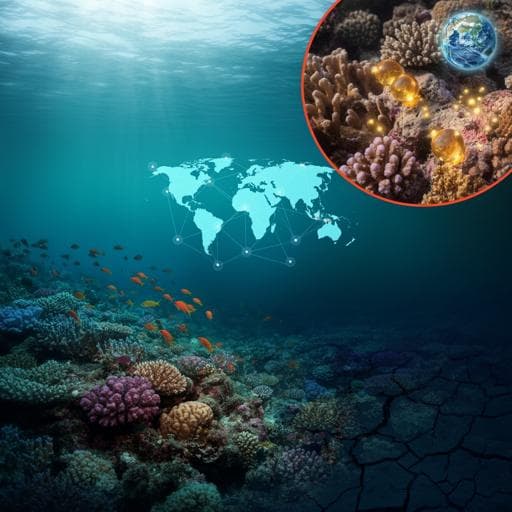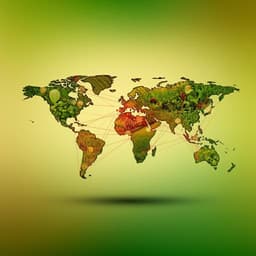
Food Science and Technology
Climate change exacerbates nutrient disparities from seafood
W. W. L. Cheung, E. Maire, et al.
This study by William W. L. Cheung and colleagues explores the vital role of seafood in nutrient availability amidst climate change challenges. While certain nutrients have seen increases, the outlook for global nutrition is grim, especially for low-income tropical countries. Mitigation strategies are essential to ensure nutritional security and health equity as projections indicate a possible decline of up to 30% in nutrient availability by 2100.
~3 min • Beginner • English
Introduction
The study addresses how the availability of key nutrients from seafood (calcium, iron, omega-3 fatty acids and protein) has changed historically and how it will be affected by climate change. Seafood provides essential micronutrients, especially in many low-income tropical countries, but global marine fisheries production peaked in the 1990s amid widespread overexploitation and shifting species productivity and distributions due to climate change. Mariculture has expanded, yet it too faces climate-related risks. Nutrient yields vary greatly among species, so changes in catch composition and productivity can alter nutrient supply. The research quantifies past and future seafood-sourced nutrient availability from capture fisheries and mariculture, evaluating global and regional disparities, and links projected changes to different warming levels to inform mitigation and adaptation for nutritional security and health equity.
Literature Review
Background research indicates: (1) marine fisheries peaked in the 1990s with ~34% of stocks over-exploited by 2017 and most others fully exploited; (2) mariculture expanded to meet seafood demand but is vulnerable to climate stressors (temperature, diseases, harmful algal blooms, feed supply constraints); (3) climate change has already altered species distributions and productivity, affecting catch composition, with continued impacts expected in line with emissions trajectories; (4) nutrient content differs markedly among taxa, meaning nutrient availability depends on species composition and productivity; and (5) there is limited understanding of historic and future changes in nutrient availability for human consumption from seafood. Prior work also notes substantial portions of fisheries catches are diverted to fishmeal and fish oil, reducing nutrients available for direct consumption, and that dietary deficiencies (especially calcium and iron) are prevalent in many regions. These studies frame the knowledge gap that this paper addresses by integrating fisheries, mariculture, and nutrient data with climate-driven projections.
Methodology
Data and scope: The authors combined global reconstructed marine fisheries catches (Sea Around Us) and FAO capture production data with a global mariculture database (Sea Around Us Global Mariculture Database) spanning 1950–2016 (fisheries) and to 2015 (mariculture). They focused on four nutrients abundant in seafood and critical to human health: calcium, iron, omega-3 fatty acids, and protein. Catches used for reduction (fishmeal and fish oil) were excluded when estimating nutrients available for direct human consumption.
Nutrient content and edible portion: Nutrient concentrations for finfish were estimated using a trait-based Bayesian model (covering 419 species) leveraging phylogeny, diet, thermal regime, and life-history traits; invertebrate nutrient values (63 species across major classes) were assigned by taxonomic levels where data existed. Edible portions were drawn from FAO, FAO/INFOODS, and Aquatic Foods Composition databases, grouped by functional/ecological categories, accounting for uncertainty with minimum–maximum bounds. Farmed and wild species were assumed to have the same nutrient content due to limited data.
Climate scenarios and Earth system models: Projections used CMIP6 models GFDL-ESM4 and IPSL-CM6A-LR under SSP1-2.6 (strong mitigation) and SSP5-8.5 (no mitigation). Extracted variables included temperatures (surface/bottom), oxygen, salinity, net primary production, sea ice, and surface advection.
Fisheries projections: The Dynamic Bioclimate Envelope Model (DBEM) projected changes in species distributions, biomass, and maximum catch potential on a 0.5° grid, constrained by species habitat preferences and oceanographic drivers. Movement was simulated with advection–diffusion–reaction equations; carrying capacity was tied to unfished biomass, habitat suitability, and primary production. Maximum catch potential assumed fishing mortality equals natural mortality, after a spin-up using 1971–2000 climatologies.
Mariculture projections: The GOMAP model projected mariculture production potential (MPP) by estimating suitable farming areas (via species distribution models and habitat suitability index), applying spatial filters (physical and socio-economic), forecasting farm-gate prices (ANN), estimating fishmeal/fish oil requirements (feed formulation model, with forage fish usage assumed at recent 2010–2014 average percentage), and using a GAM linking suitability, prices, and crude protein index to MPP. Projections were made by EEZ under SSP1-2.6 and SSP5-8.5.
Computation of nutrient availability: Historical nutrient availability was computed by multiplying species-specific edible biomass by nutrient concentrations. Future availability was estimated by scaling reported production by projected relative changes in maximum catch potential (DBEM) and mariculture production potential (GOMAP) relative to 1991–2010 baselines, then converting to nutrients with the nutrient content data. Results were analyzed globally and by EEZ, including tropical (±23.5°) versus extra-tropical contrasts.
Uncertainty and warming linkage: Monte Carlo simulations (N=1,000) propagated uncertainties in nutrient contents and edible portions to derive 95% ranges. The authors also related projected nutrient availability to global surface air temperature anomalies (relative to 1850–1900) using linear regressions to quantify percent change per degree Celsius of warming. Coastal population projections (100 km coastal band) under SSP5 informed per-capita considerations.
Data/code availability: All data and code are archived on Dryad (doi:10.5061/dryad.b5mkkwhdd).
Key Findings
Historical trends:
- Global availability of calcium, iron, omega-3 fatty acids, and protein from fisheries and mariculture rose from 1950 to a peak in the early 1990s, then declined significantly thereafter (average −2.2% per year ±0.8 s.e. across nutrients; p < 0.01), largely due to declines in finfish fisheries.
- A substantial share of catches was used for fishmeal and fish oil (on average, 33% of total fisheries catches since the 2000s), reducing nutrients available for direct human consumption. Excluding reduction fisheries, iron, calcium, and omega-3 availability for human consumption increased (p < 0.01) since the 1990s, while protein stagnated (p > 0.05).
- Invertebrate fisheries and mariculture increased nutrient supplies since the 1990s, but their smaller production volumes and lower edible fractions limited impact on overall trends. Rapid growth of feed-reliant finfish/crustacean mariculture increased fishmeal and oil demand.
Future projections (fisheries):
- By 2050 relative to 2000, fisheries-derived nutrient availability declines 5–10% under SSP1-2.6 and 8–15% under SSP5-8.5.
- By 2100 under SSP5-8.5, availability declines are largest for minerals: calcium −41% (36–45%) and iron −37% (32–41%); omega-3 −22–31%; protein −18–25%. Under SSP1-2.6, declines are about 10% for calcium and iron by 2050 and 2100.
- Drivers include large projected decreases in maximum catch potential of pelagic fishes (−46% to −60% by 2100 under SSP5-8.5), which are nutrient-rich in calcium and iron. Invertebrates decline little (≈ −2% by 2100) but cannot compensate due to smaller share and edible biomass.
Future projections (mariculture):
- By 2050 relative to 2000, mariculture-derived calcium increases 11–23% and protein 18–45% across scenarios; omega-3 availability declines due to reduced potential of large finfish groups rich in omega-3.
- Under SSP1-2.6, mariculture nutrient availability remains relatively stable 2050–2100; under SSP5-8.5, it declines after mid-century.
- Mariculture currently supplies ~15% of seafood production and 10–25% of the four nutrients; projected gains are insufficient to offset fisheries losses globally. By 2100 under SSP5-8.5, net mariculture nutrient availability for calcium, iron, and omega-3 shows a 20–30% loss relative to the 2000s.
Regional disparities:
- Tropical EEZs: by 2100 under SSP5-8.5, nutrient availability from fisheries declines ~22–25% and from mariculture ~51–61% (relative to 2010), while extra-tropical EEZs see small gains.
- Hotspots of fisheries nutrient losses include the tropical Pacific, Southeast Asia, Pacific Island nations, and West Africa; some may exceed −60% by 2050 under no mitigation. Mariculture losses are greatest in high-production areas (Australia, Chile, China, New Zealand, Norway), where dependence on seafood is lower. Projected mariculture increases in some areas cannot offset fisheries losses.
- Many countries with declining nutrient availability also face >50% coastal population growth by 2050 (e.g., Nigeria, Sierra Leone, Solomon Islands), compounding per-capita declines; high-latitude countries (e.g., Finland, Russia) may see gains.
Scaling with warming:
- Globally, seafood-sourced nutrient availability declines 3.1–6.5% per °C of warming; calcium is most sensitive (−6.5% ±0.2 s.e. per °C).
- Lower-income countries experience 9.7–11.6% declines per °C, about 2–3× the global average. At ~4 °C warming by 2100, lower-income countries face ~−30% nutrient availability; at 1.5–2.0 °C, ~−10%.
Discussion
Findings show that despite growth in mariculture and invertebrate harvests, nutrients available for direct human consumption from capture fisheries have stagnated or declined since the 1990s, with climate change projected to exacerbate reductions—especially for mineral micronutrients—through significant losses in pelagic fish catch potential. Regional disparities are stark: tropical, lower-income countries that rely most on seafood for micronutrients face the largest declines, while extra-tropical regions may experience modest gains, raising equity and food security concerns.
Mitigation that limits warming to well below 2 °C substantially reduces projected losses relative to a high-emissions pathway. Complementary adaptation measures could partially offset impacts: reducing diversion of catches to fishmeal/oil via alternative feeds; nutrient-sensitive fisheries governance that targets species and portfolios maximizing nutrient yield; adaptive fisheries management to account for shifting ranges and productivity; and climate-smart mariculture development emphasizing resilient, nutritious species and sustainable feed innovations. Trade dynamics may allow higher-income countries to buffer domestic declines via imports, potentially intensifying competition and constraining access for lower-income nations. Integrating nutrient goals into ocean planning and prioritizing access for nutrient-deficient populations are critical to sustaining health benefits from aquatic foods under climate change.
Conclusion
This study quantifies historical and projected changes in seafood-sourced nutrient availability, integrating fisheries and mariculture production with nutrient composition and climate-driven projections. It shows that climate change will diminish availability of key nutrients globally—most acutely in tropical, lower-income countries dependent on seafood—with minerals (calcium, iron) particularly sensitive. Even under strong mitigation, risks persist, but are markedly lower than under high emissions. Mariculture growth offers limited compensation and is itself vulnerable.
Main contributions include: (1) a unified global assessment of nutrient availability trends from marine fisheries and mariculture; (2) explicit linkage of nutrient availability to warming levels (percent decline per °C); and (3) identification of regional inequities and hotspots of risk.
Future research should: (a) refine nutrient composition estimates, especially for farmed species and across tissues; (b) incorporate technological and systemic changes in aquaculture (feeds, species diversification) and new mariculture geographies; (c) integrate freshwater fisheries and aquaculture; (d) model trade, access, and affordability to capture nutritional outcomes; and (e) develop and test nutrient-based fisheries and aquaculture management strategies under climate change.
Limitations
- Nutrient composition data are incomplete, particularly for invertebrates and farmed species; the analysis assumes farmed and wild nutrient contents are the same.
- Edible portion estimates vary by species and geography; although uncertainty was propagated via Monte Carlo simulations, true variability may be greater.
- Mariculture projections focus on countries with established production; potential expansion into new regions and future technological changes (e.g., feed formulations, systems) were not explicitly modeled.
- Freshwater fisheries and aquaculture, important sources of nutrients in many regions, were excluded.
- Projections depend on two CMIP6 Earth system models and specific fisheries (DBEM) and mariculture (GOMAP) modeling frameworks, introducing structural and scenario uncertainties.
- Trade, distribution, and affordability dynamics were not modeled in the quantitative projections, though discussed qualitatively.
- Estimates of nutrients available for human consumption exclude reduction fisheries products and rely on historical proportions for fishmeal/oil usage, which may change over time.
Related Publications
Explore these studies to deepen your understanding of the subject.







